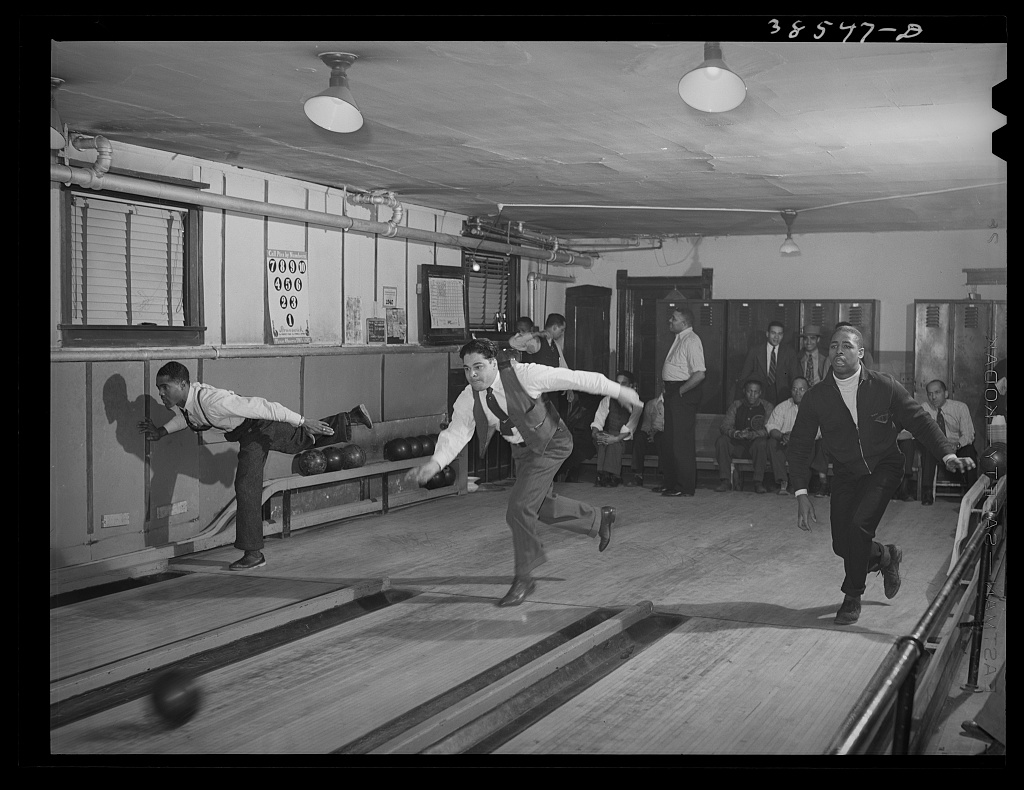Imagine your local bowling alley. The sound of a heavy ball hitting the floor just before the bounce of the pins hitting the floor. The distinct smell, which only exists in a bowling alley, of pine wax, stale beer, nacho cheese, and feet. The balloons from a children’s party, the crane machines, the arcade cabinets. The focused gaze of a near-professional in a bowling shirt vs. the rowdy laughter of college students just looking for a break from homework.
I was surprised to learn that bowling alleys weren’t always viewed as the chill, family-friendly sites of fun they are now. In fact, for much of their early history in the United States, the bowling alley was a place of wickedness and immorality. Bowling alleys were often housed in saloon basements, leading to their association with drinking and rowdy behavior. There was also a level of classism in the dislike for the game because it was popular among the working class. Many bowling alleys ran deals such as “buy two beers, get a free game,” and the relatively inexpensive cost led to bowling being viewed as a “poor man’s game.” And for much of the 19th and early 20th centuries, it was a man’s game. Women’s participation was restricted, likely due to a social stigma around women hanging out in debaucherous places like saloons. Adolescent boys were allowed in the alleys, unlike women; they were hired as “pinboys” whose job it was to reset the pins after every frame.
These labor practices didn’t help bowling’s image, especially as child labor became an increasingly contentious issue in the early 20th century.
Connecticut even banned nine-pin bowling in 1841 in an attempt to curb gambling and crime. One likely apocryphal story cites this ban as the reason for the invention of the modern ten-pin bowling because only nine-pin bowling was banned. Want to play without inciting a fine? Just add a pin.
One Alleghany County man was so incensed with his local bowling alley that he even went to the court to have something done. In 1910, J.R. McMunn filed his bill with the Alleghany County Chancery Court. His chief complaint was the noise, declaring “the noises are so loud that they penetrate your orator’s dwelling house and so disturb and annoy him and his family in the peace and quiet that they should enjoy so as to render his said dwelling house practically uninhabitable…these noises are kept up frequently in the day time, but more frequently at night.” The noises began in the early evening and continue “until some times as late as eleven o’clock p.m.” [emphasis added]. McMunn asked the court to declare the bowling alley a “nuisance” and to restrain the business from operating in the building near his home.
It wasn’t just the noise of the game he criticized, but also the noise of the patrons. During the alley’s hours of operation, “large numbers of men and boys congregate in said building…said men and boys make a great noise with their feet tramping over the floor and frequently make loud noises in clapping their hands and hollowing and talking loudly.” An affiant claimed the noise was so great from the clatter of the games and the clamor of the patrons so as to cause “the plastering in said McMunn’s house…becoming loose and dropping off.”
While most of his complaints were due to the terrible racket caused by the game itself, McMunn also complained about many of the same things which gave bowling its poor reputation. He complained about the general air of vulgarity brought about by the presence of the bowling alley, because “boys…hollow and curse and use vulgar language.” An affidavit in support of McMunn’s bill elaborated, “boys…hollow and whistle and make noises…these boys hollow to one another in such a loud manner frequently as to create the impression that they are trying to annoy those living near said alley; that some times they use vulgar language to such extent that affiant is obliged to protest and require them to desist.”
The modern-day bowling alley, as an all-ages establishment, was the result of Prohibition and the Great Depression. Once alcohol was banned in the United States, bowling alleys were disassociated with saloons and alcohol.
And when the Great Depression ransacked family budgets, the perspective of bowling as a “poor man’s game” was no longer a detraction. When everyone was a poor man, who cared if something was cheap?
No decrees were found with the suit, so whether J.R. McMunn ever found peace from the cacophony is unclear. Perhaps the business shuttered, perhaps the McMunns moved from their home. Or perhaps, with enough time and social change, McMunn decided to join the game.
To read this case in its entirety, see Alleghany County Chancery Cause: 1910-001: JR McMunn vs. William M. England. Alleghany County chancery causes, 1881-1913, have been added to 1831-1880 Alleghany County causes already on the Chancery Records Index. The processing and scanning of these records was made possible by funding from the innovative Circuit Court Records Preservation Program (CCRP), a cooperative program between the Library of Virginia and the Virginia Court Clerks Association (VCCA), which seeks to preserve the historic records found in Virginia’s Circuit Courts.
Header Image Citation
Russell Lee, Untitled photo, possibly related to: Bowling alley on southside of Chicago, Illinois, April 1941, photograph, Library of Congress Prints and Photographs Division, https://www.loc.gov/item/2017788744/.








